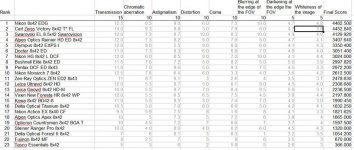MagpieCorvidae
Well-known member
I decided to take the Allbinos 8x42 data and re-rank them.
Basically, I isolated only the optical metrics (Transm, ChromAberration, Astigmatism, Distortion, Coma, EdgeBlur, EdgeDarken).
The final score for each binocular is a product of three values:
Final score = A * B * C
A = Transmission
B = Chromatic Aberation
C = Astigmatism + Distortion + Coma + EdgeBlur + EdgeDarken
EDIT:
It is essential that the ranking formula must contain multiplication (this way, zero transmission = zero score, no questions asked) ... and in this case transmission and color fringing control are singled out as absolute must-have; a binocular must pass these two qualifications before considering any further.
Additive is what Allbinos is already using and there serious problems with it.
Essentially you could theoretically make a binocular out of welder's glass that is so dim and black that even the sun is barely visible so that
Black useless Binocular = 0 + 10 + 10 + 10 + 10 + 10 + 5 + 5 = 60
$1000 Binocular = 13 + 8 + 7 + 8 + 7 + 8 + 4 + 4 = 59
So a black useless binocular can be made to rank higher (if we use high grade welder glass on it) than a normal $1000 binocular when the ranking formula is purely additive.
Basically, I isolated only the optical metrics (Transm, ChromAberration, Astigmatism, Distortion, Coma, EdgeBlur, EdgeDarken).
The final score for each binocular is a product of three values:
Final score = A * B * C
A = Transmission
B = Chromatic Aberation
C = Astigmatism + Distortion + Coma + EdgeBlur + EdgeDarken
EDIT:
It is essential that the ranking formula must contain multiplication (this way, zero transmission = zero score, no questions asked) ... and in this case transmission and color fringing control are singled out as absolute must-have; a binocular must pass these two qualifications before considering any further.
Additive is what Allbinos is already using and there serious problems with it.
Essentially you could theoretically make a binocular out of welder's glass that is so dim and black that even the sun is barely visible so that
Black useless Binocular = 0 + 10 + 10 + 10 + 10 + 10 + 5 + 5 = 60
$1000 Binocular = 13 + 8 + 7 + 8 + 7 + 8 + 4 + 4 = 59
So a black useless binocular can be made to rank higher (if we use high grade welder glass on it) than a normal $1000 binocular when the ranking formula is purely additive.
Attachments
Last edited:





